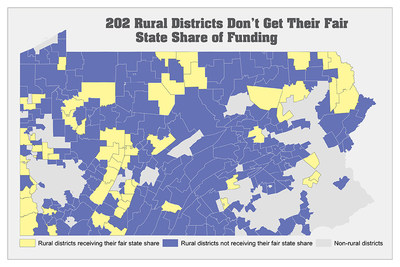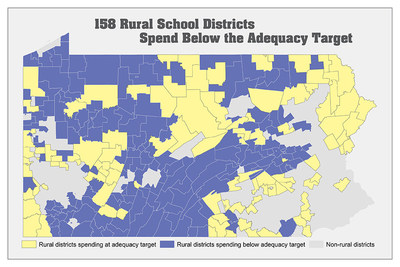New PPC Report Finds Spending Impacts Student Performance in Rural Schools
Report underscores need for sustained education funding increases
HARRISBURG, Pa., March 20, 2017 /PRNewswire-USNewswire/ -- State funding for public education impacts student achievement in rural Pennsylvania according to a report released by Pennsylvania Partnerships for Children that looks at how spending levels in the state's 260 rural school districts impacts student results on the Pennsylvania System of School Assessments (PSSAs).
The report, "Spending Impact on Student Achievement: A Rural Perspective," shows when rural school districts spend below the amount needed to educate students – or their adequacy target – that underspending is a direct result of inadequate state support and negatively impacts student achievement.
"What this report tells us is that insufficient school funding is not just an urban or suburban problem, it is a state problem," said PPC President and CEO Joan Benso. "With budget negotiations underway, our hope is for policymakers to consider the widespread, significant impact that underfunding public education has on all students and their achievement. Today's students are the key to our future economic viability."
According to the report, 202 rural districts are not receiving their fair share of state funding, forcing them to either spend less and risk student achievement, which the report reveals is happening already, or increase local taxes.
The report found that more than a third of 3rd grade students attending rural school districts scored below proficient on the English Language Arts (ELA) PSSA, and two-thirds of students attending rural districts scored below proficient in the 8th grade Mathematics PSSA.
Of the 158 rural districts that are spending below their adequacy target, 81 are doing so by 10 percent or more and their students are performing even worse than the above rural average.
"When schools have adequate funding, they can support qualified teachers, up-to-date textbooks, small class sizes and other supports that help students achieve," she said. "Making sure districts have enough funding to educate students is a shared state-local responsibility but these results underscore the need for greater state investments because too many children in rural Pennsylvania are falling behind because the state isn't providing their fair share of education funds."
In rural school districts spending between 10 percent and 25 percent below the adequacy target, nearly 40 percent of students were not proficient on the 3rd grade English Language Arts and nearly 70 percent of students were not proficient in 8th grade Math PSSAs. Some districts did even worse:
- More than 45 percent of students in the Redbank Valley School District in Clarion and Armstrong counties, and 49 percent of students in the Wyalusing Area School District located in Wyoming and Bradford counties.
- Approximately 82 percent of 8th grade students in the Mifflin County School District and 91.3 percent of students in Otto-Eldred School District did not meet proficiency in Math.
In school districts spending between 25 percent to 50 percent below their adequacy target, 45 percent of 3rd grade students were not proficient as measured by the ELA PSSA, and 80 percent were not proficient in 8th grade math. The results are particularly distressing in these districts:
- Approximately 61.2 percent of 3rd grade students in Mount Union School District in Huntingdon and Mifflin counties did not meet proficiency in English Language Arts, and only 14.7 percent of 8th graders met proficiency in Mathematics.
- Only 19.5 percent of students in the Shamokin School District in Northumberland County and 14.5 percent of students in the Claysburg-Kimmel School District in Bedford and Blair counties were proficient on the 8th grade Math PSSA.
"State assessment scores are not the only measure of student achievement, but student performance in rural school districts should be of great concern to policymakers, parents and communities," Benso said. "We have made great strides over the last two years with basic education funding increases and the new fair funding formula, but the amount of resources provided to schools remains inadequate," she said.
The Campaign for Fair Education Funding, of which PPC is a founding member, said the Governor's proposed increase of $100 million for basic education funding is a strong investment in a difficult budget year, but that giving all students the resources they need to succeed will require significant and sustained funding increases over several years, run through the fair funding formula policymakers adopted last year based on the recommendations of the bipartisan Basic Education Funding Commission (BEFC).
"Every child should have an equal opportunity to attend a local public school that has adequate resources to ensure that he or she can learn and meet state academic standards. Unfortunately, that is not the case for children living in rural communities, and this report is a wakeup call that we need to increase state funding for basic education if we want students to succeed," she said.
The report, along with data for each of Pennsylvania's 260 rural school districts, is available at: http://www.papartnerships.org/work/k12/k12-reports.
Pennsylvania Partnerships for Children is a strong, effective and trusted voice to improve the health, education and well-being of children and youth in the commonwealth. For 25 years, PPC's public policy victories have helped countless children learn, thrive and succeed, regardless of circumstances. PPC is statewide, independent, non-partisan and non-profit.
SOURCE Pennsylvania Partnerships for Children
Related Links
WANT YOUR COMPANY'S NEWS FEATURED ON PRNEWSWIRE.COM?
Newsrooms &
Influencers
Digital Media
Outlets
Journalists
Opted In



Share this article